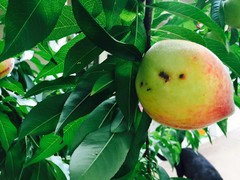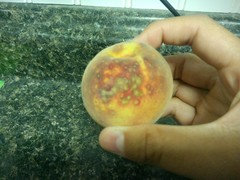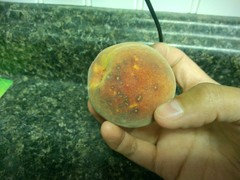Help! Dark spots on peaches (w/ pictures)
digdugdiggy
13 years ago
Featured Answer
Comments (22)
Scott F Smith
13 years agolast modified: 9 years agodigdugdiggy
13 years agolast modified: 9 years agoRelated Professionals
Bridgetown Landscape Architects & Landscape Designers · East Rancho Dominguez Landscape Architects & Landscape Designers · Mountain Brook Landscape Architects & Landscape Designers · Signal Hill Landscape Architects & Landscape Designers · Bell Gardens Landscape Contractors · Fuquay-Varina Landscape Contractors · Hayden Landscape Contractors · Oklahoma City Landscape Contractors · Palm Beach Gardens Landscape Contractors · Pine Hills Landscape Contractors · Saint George Landscape Contractors · Sammamish Landscape Contractors · San Rafael Landscape Contractors · South Farmingdale Landscape Contractors · Woodburn Landscape Contractorsjellyman
13 years agolast modified: 9 years agodigdugdiggy
13 years agolast modified: 9 years agoolpea
13 years agolast modified: 9 years agojellyman
13 years agolast modified: 9 years agodigdugdiggy
13 years agolast modified: 9 years agoRenee Overby
8 years agorphcfb14
8 years agoChristy Green
8 years agoClaudia Bryant
7 years agoDeShay Carey
7 years agogarybeaumont_gw
7 years agorphcfb14
7 years agoDeShay Carey
7 years agorphcfb14
7 years agofruitlovernc7b8a
7 years agogarybeaumont_gw
7 years agorphcfb14
7 years agofruitlovernc7b8a
7 years agoumkallah24
5 years ago
Related Stories

COLORPick-a-Paint Help: How to Quit Procrastinating on Color Choice
If you're up to your ears in paint chips but no further to pinning down a hue, our new 3-part series is for you
Full Story
EDIBLE GARDENSHow to Grow Your Own Peaches and Nectarines
Make gardening a little sweeter with these juicy fruits, which you can eat after plucking or preserve for later
Full Story
ORGANIZINGHelp for Whittling Down the Photo Pile
Consider these 6 points your personal pare-down assistant, making organizing your photo collection easier
Full Story
MOVINGRelocating Help: 8 Tips for a Happier Long-Distance Move
Trash bags, houseplants and a good cry all have their role when it comes to this major life change
Full Story
REMODELING GUIDESKey Measurements for a Dream Bedroom
Learn the dimensions that will help your bed, nightstands and other furnishings fit neatly and comfortably in the space
Full Story
COLORPaint-Picking Help and Secrets From a Color Expert
Advice for wall and trim colors, what to always do before committing and the one paint feature you should completely ignore
Full Story
SELLING YOUR HOUSE10 Low-Cost Tweaks to Help Your Home Sell
Put these inexpensive but invaluable fixes on your to-do list before you put your home on the market
Full Story
LIFE12 House-Hunting Tips to Help You Make the Right Choice
Stay organized and focused on your quest for a new home, to make the search easier and avoid surprises later
Full Story
MOST POPULAR7 Ways to Design Your Kitchen to Help You Lose Weight
In his new book, Slim by Design, eating-behavior expert Brian Wansink shows us how to get our kitchens working better
Full Story












Scott F Smith